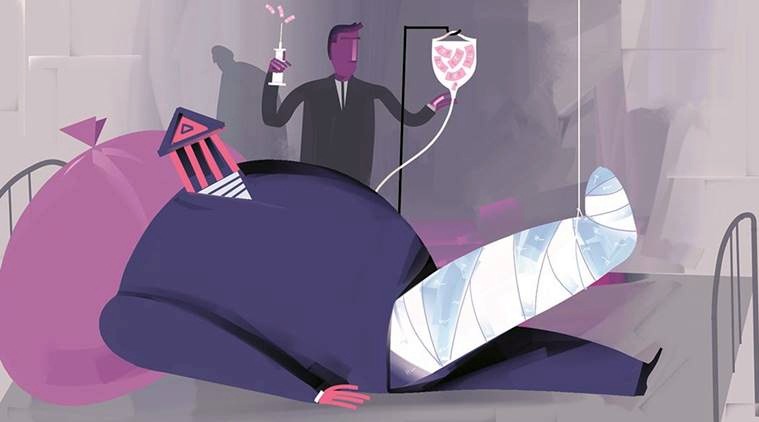July 14, 2023
Indian Banks witness significant improvement in NPA

Source: The Indian Express
Introduction
- The Indian banking sector has experienced a notable turnaround in its non-performing assets (NPA) ratio, reflecting an overall improvement in its financial health.
- After grappling with the highest NPA ratio among emerging economies just a few years ago, Indian banks have made significant progress in reducing bad loans.
Understanding Bad Loans/Non-Performing Assets (NPAs)
- Bad loans or NPAs are loans that have been classified as non-performing assets due to the borrower’s inability to fulfill repayment obligations.
- Typically, a loan is labeled as an NPA when the borrower fails to make payments for a specified period, usually 90 days or more.
Key Classifications of NPAs
- Gross Non-Performing Assets (GNPA): This refers to the total amount of loans or advances that have been defaulted by borrowers.
- Net Non-Performing Assets (NNPA): NNPA is derived by deducting the provision amount from the GNPA. Provision refers to the funds set aside by banks or financial institutions as a precautionary measure to cover potential losses arising from NPAs.
Background and Current Situation
- During the second quarter of 2019, the NPA ratio in Indian banks reached a concerning level of 9.2%, indicating that nearly one in ten loans had become bad. The severity of the problem became evident when the Reserve Bank of India (RBI) conducted an extensive Asset Quality Review in 2016, revealing the true extent of bad loans.
- However, in recent years, the NPA ratio has been on a downward trend, even during the challenging times of the COVID-19 pandemic. This positive trajectory can be attributed to several factors contributing to the decline in NPAs.
Factors Contributing to the Decline in NPAs
- Insolvency and Bankruptcy Code (IBC): The implementation of the Insolvency and Bankruptcy Code in 2016 played a crucial role in the recovery of distressed loans. It provided a structured and time-bound framework for resolving such assets, leading to improved NPA management and recovery.
- Shift towards Personal Loans: Banks strategically shifted their lending focus from industries to personal loans. This move reduced exposure to sectors heavily impacted by the pandemic, mitigating the risks of loan defaults and lowering the NPA ratio.
- Impact of COVID-19-related Moratoriums: Concerns regarding potential increases in NPAs resulting from COVID-19-related moratoriums were largely unfounded. The data suggests that the measures implemented to support borrowers during the pandemic were effective in preventing a major NPA crisis.
- Write-offs: The reduction in NPAs, particularly in FY20, can be attributed to the practice of writing off bad loans. Banks voluntarily wrote off NPAs to maintain healthy balance sheets, positively impacting the overall NPA ratio. However, concerns arise regarding the sustainability of this approach in the long run.
Understanding Write-offs
- Write-offs involve removing non-performing assets (NPAs) from a bank’s balance sheet. When a loan becomes irrecoverable, the bank may decide to write it off as a loss, no longer considering it an asset.
Concerns Highlighted Regarding Write-offs
- Sustainability of NPA Reduction: Heavy reliance on write-offs raises doubts about achieving sustainable NPA reduction without effective recovery measures.
- Adequacy of Provisioning: Insufficient provisions to cover losses due to write-offs can weaken a bank’s financial position and its ability to absorb future shocks.
- Transparency and Accountability: Ensuring transparent and accountable write-off processes is crucial to prevent misuse and maintain trust in the banking system.
- Impact on Lending Capacity: Write-offs reduce available capital, limiting a bank’s ability to lend and support economic growth. Inadequate replenishment may further constrain lending.
Implications of Declining NPAs for Banks
- Improved Asset Quality: A decrease in NPAs indicates an improvement in the asset quality of banks, reflecting healthier lending practices and reduced credit risk. Banks with lower NPAs are better positioned for stability and profitability in their loan portfolios.
- Enhanced Financial Health: Declining NPAs contribute to the overall financial health of banks. As the burden of bad loans decreases, banks can allocate resources more efficiently and utilize capital for productive purposes, enhancing profitability and strengthening their financial position.
- Increased Profitability: Lower NPAs positively impact banks’ profitability by reducing expenses associated with NPA resolution and provisioning. This improvement in the bottom line results in higher profits for banks.
- Strengthened Capital Position: A decline in NPAs leads to a strengthened capital position for banks. As they recover or resolve NPAs, banks can allocate capital more effectively, building buffers against potential losses and ensuring stability and sustainable lending practices.
- Improved Investor Confidence: Decreasing NPAs can boost investor confidence in the banking sector, attracting investments and contributing to stability and growth.
- Enhanced Lending Capacity: With lower NPAs, banks can allocate more funds toward fresh lending and credit expansion. This supports economic growth by facilitating increased lending to productive sectors of the economy.
The Conclusion
- Indian banks have made significant progress in reducing NPAs, leading to improved financial health, profitability, and investor confidence.
- However, concerns remain regarding the sustainability of this trend, primarily due to the heavy reliance on write-offs.
- To ensure long-term stability, banks must prioritize prudent lending practices, effective risk management, and the implementation of robust recovery mechanisms.
Mains Exam Practice Question:
Discuss the measures taken by the Reserve Bank of India (RBI) and the Government of India to address the issue of non-performing assets (NPAs) in the Indian banking sector.
January 30, 2025
January 20, 2025
January 14, 2025
